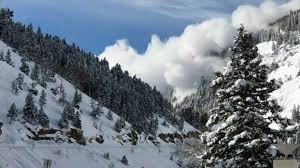Snow avalanche is a sudden emergence of a mass of snow, ice down the mountain slopes.Avalanches are natural phenomena that occur when a considerable mass of snow falls off and slides down the slopes of hills.Avalanches account for about 50% of accidents in the mountains. An avalanche is formed on a slope with an inclination angle of 15–30 °. The most avalanche-like periods of the year are winter and spring, which account for up to 95% of avalanches.

Avalanches occur as a result of the accumulation of snow in mountainous areas where the slopes of the mountains and the concurrence of a series of physical and meteorological factors give rise to movements of large amounts of snow.
Avalanche types
Avalanche of loose snow
It is the type of avalanche that occurs after heavy snowfall. Fresh snow, accumulating more than 25 cm thick, is conducive to slipping, especially when it falls on a mass of smooth snow. This type of avalanche usually carries more and more snow on its route.
Plate avalanche
The plate avalanche occurs when a compact snow surface falls off and slides down the slope. It looks like a block of snow cut from its surroundings. It is a fairly frequent type of avalanche and carries great risks.
Avalanche of wet snow
The avalanche of wet snow is typical of the season when temperatures begin to rise, towards the end of winter and the beginning of spring. They are usually slower and lower in suspension.
Avalanches can be formed by any of the following causes:
- Due to lack of homogeneity between the snow layers.
- Due to excess weight, when the amount of snow is greater than a surface can withstand.
- By rain, when a recent layer penetrates, and it slips due to the weight of the water.
- Due to changes in ambient temperature that may affect snow cohesion.
- Due to the soil conditions, especially when they are this, it is suitable for the sliding of materials along their surface (clay, smooth, wet or icy terrain).
Depending on their magnitude, avalanches can be classified on a scale ranging from weak to very strong, the latter being highly dangerous.
Depending on the victims and damages that an avalanche can cause, it can also be considered a natural disaster.
Avalanche can also designate, in a general way, any considerable mass of a material that emerges and precipitates from a slope. For example: “The detachment of the tree produced an avalanche of land.”
The word avalanche can also be used figuratively in reference to a large amount of something. For example: avalanche of kisses, avalanche of praise, human avalanche, etc.
Causes of avalanche movement:
- heavy snowfall or accumulation of a large amount of snow on the slopes during its wind transfer;
- low traction force between the underlying surface and newly fallen snow;
- thaw and rain, followed by the formation of a slippery water layer between the underlying surface and fresh snow;
- a sharp change in air temperature;
- mechanical, acoustic, wind effect on snow cover [5].
The speed of the avalanche movement is 20–100 m / s. The strength of an avalanche strike can amount to tens of tons per square meter, which is a serious enough damaging factor that damages and destroys everything in its path.
By the nature of the movement, avalanches are divided into the following types:
- persons – snow landslides descending over the entire surface of the slope;
- jumping avalanches – avalanches, conducting part of their journey in flight, since the obstacles encountered on their way become springboards for them;
- tray avalanches – avalanches that pass along grooves, corridors and weathering zones of rocks in the form of furrows.
Preventive measures:
- study, observation, forecasting, informing the population about the possible threat of avalanche;
- training people in safe actions in avalanche-prone areas;
- artificial induction of avalanches;
- use of avalanche plantations;
- creation of engineering structures in avalanche-prone areas, including canopies, tunnels, and corridors.
With the threat of snow avalanche, ski slopes, mountain roads and railways are closed, people are not allowed to go to the mountains, rescue teams are becoming more active.
The actions of the population during the avalanche
- When an avalanche appears on your way, you must quickly drop the backpack and run away from the path of the avalanche to the side (down and to the side at a 45 ° angle).
- While on the move, you need to shout loudly so that others notice where they are blowing you, as long as possible. As soon as the snow begins to “cover” you, you must close your mouth with your hand so that it does not hit the snow.
- Using swimming movements, you should try to stay on the surface of the snow stream.
- When the snow slows down its movement, it is necessary to make an air tank in front of the face with your hands, with the movements of your whole body, expand the space around you and stick out any part of your body to the surface to see it.
- It must be remembered that the snow hardens very quickly, becoming covered with an ice crust, preventing the flow of air.
- You can shout only when speech or footsteps are right next to you (above you), since the sound from the depth of the snow layer is heard only in the immediate vicinity of the source.
